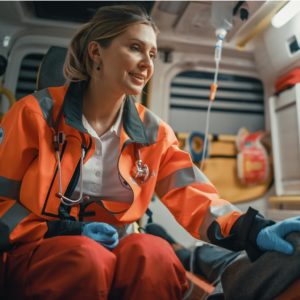Interventional Care


We notice that you are visiting us from . This site only services US-based visitors. Would you like to visit the site that is appropriate for your location?

Emergency Medical Services (EMS) and other pre-hospital providers are fully aware of their risks when called to duty for a car accident, burning building, or potential drowning. But the invisible risks are often not top of mind as they respond to that 911 call. These are the infectious risks or exposures that emergency responders may face daily. These exposures may occur as contact, airborne, or droplet transmission with various pathogens as the culprits of concern.
The focus for years has been on the bloodborne pathogens, Hepatitis B and C and Human Immunodeficiency Virus (HIV), and rightly so since many calls will involve potential exposure to blood or bodily fluids. More recently, pathogens such as Methicillin-Resistant Staphylococcus aureus (MRSA) and other multi-drug resistant organisms such as MDR-Acinetobacter species and Candida auris have become quite a concern in all healthcare settings including emergency transport.
An article by Bitely et.al.1 addresses the special challenges encountered by EMS, which places the workers and their patients at potentially increased risk of infection. These challenges, heightened in EMS versus in-hospital care, deserve focused attention and include:
Some challenges are not easy to address with sustainable solutions due to the emergency nature of the business and the physical environment thereof. However, one item does stand out for further discussion: cleaning and disinfection of equipment and surfaces.
EMS providers work within small, enclosed spaces that function as mobile healthcare units. This means that the space contains larger pieces of equipment (stretcher, IV poles, monitors, oxygen tanks) in addition to smaller items of medical supplies in storage containers. The proximity of workers, patients, and the environment lends itself to easier contamination of the equipment and overall work surfaces which becomes a potential source of infection if not properly disinfected.
There is no shortage of excellent EPA-registered healthcare disinfectants available for decontamination of medical equipment and surfaces. So, what is the problem? Even with awareness of the need to disinfect contaminated surfaces and the availability of user-friendly disinfectant formats, workers have cited the lack of time and frequency needed to disinfect as a significant challenge to ensuring a sanitary environment. 2
Continuous active disinfection (CAD) is an available option that could become the preferred solution for EMS disinfection. What is CAD? CAD can be achieved by various methods: copper-impregnated surfaces, UV light emission at human-safe wavelengths, or via a proprietary quaternary ammonium/alcohol-based disinfectant with residual antimicrobial activity for 24 hours on ESKAPE* pathogens. Each of these methods has been studied and reported in the literature.
A major disadvantage to copper-impregnated surfaces is the cost in addition to the necessity of still applying a standard disinfectant for cleaning. 3 UV light emission at approximately 405 nanometers exposure is safe to humans and bactericidal, however, significant kill is only achieved over longer periods of time; for example, 10-15 hours for a 90% reduction in bacteria.4 This UV light technology differs from UV-C devices that are deployed in vacant rooms and produce light emissions between 200-280 nanometers. Humans cannot be present during this disinfection and the organisms are inactivated in a more rapid timeframe.
A more promising solution is an EPA-registered healthcare disinfectant that provides continuous antimicrobial activity over an extended period of time, ex. 24 hours, and is currently available on the market. This product, Sani-24® Germicidal Disposable Wipes, provides initial disinfection against 27 microorganisms at one minute contact time, but also provides 24-hour residual activity against the ESKAPE* pathogens which cause over 40% of healthcare-associated infections.5
Recent studies have shown that the Sani-24 germicidal solution has been validated for use on bedrails6 and portable medical equipment in real-life clinical settings.7 These studied surfaces are very similar to surfaces seen within EMS transport vehicles. This method of disinfection can mitigate risks associated with recontamination between patient transports and alleviate issues associated with a lack of time for disinfection of surfaces that are not visibly contaminated or used during a medical transfer. Of course, any product will not be effective if not used appropriately.
Continuous active disinfectants are a viable solution for EMS environmental disinfection in reducing infection transmission; however, they are not a solution for poor compliance with environmental disinfection practices or poor hand hygiene. Let’s not make that the next emergency!
1 Bitely C, Miller B, Glauser J. EMS Disease Exposure, Transmission, and Prevention: a Review Article. Curr Emerg Hosp Med Rep. 2019;7(4):135-140. doi:10.1007/s40138-019-00200-6
2 Barr N, Holmes M, Roiko A, Dunn P, Lord B. Challenges for environmental hygiene practices in Australian paramedic-led health care: a brief report. Am J Infect Control. 2018;46(6):723–725.
3 2016 ECRI Report: https://www.ecri.org/Resources/AHCJ/2016_Resources/Antimicrobial_Copper_Surfaces_for_Reducing_Hospital-acquired_Infection_Risk.pdf
4 Infect Control Hosp Epidemiol. 2018 October; 39(10): 1250–1253. doi:10.1017/ice.2018.200.
5 Magill, et.al. Multistate point-prevalence Survey of Health Care-Associated Infections, N Engl J Med 2014;370:1198-208 and Boucher, et.al. Bad Bugs, No Drugs: No ESKAPE! An Update from the Infectious Diseases Society of America, Clinical Infectious Diseases 2009; 48:1–12
6 Schmidt et al. American Journal of Infection Control, 2019, ISSN: 0196-6553, Vol: 47, Issue: 6, Page: 732-734
7 Donskey et. al. Infection Control & Hospital Epidemiology, 2021 1-3. doi:10.1017/ice.2021.66
*Enterococcus faecium, Staphylococcus aureus, Klebsiella pneumoniae, Acinetobacter baumannii, Pseudomonas aeruginosa, and Enterobacter species.